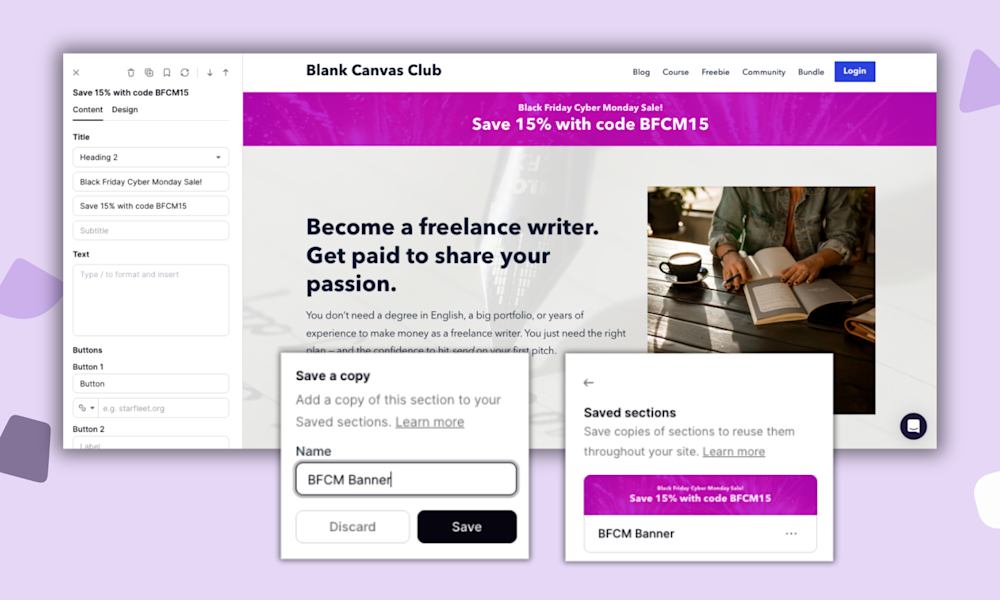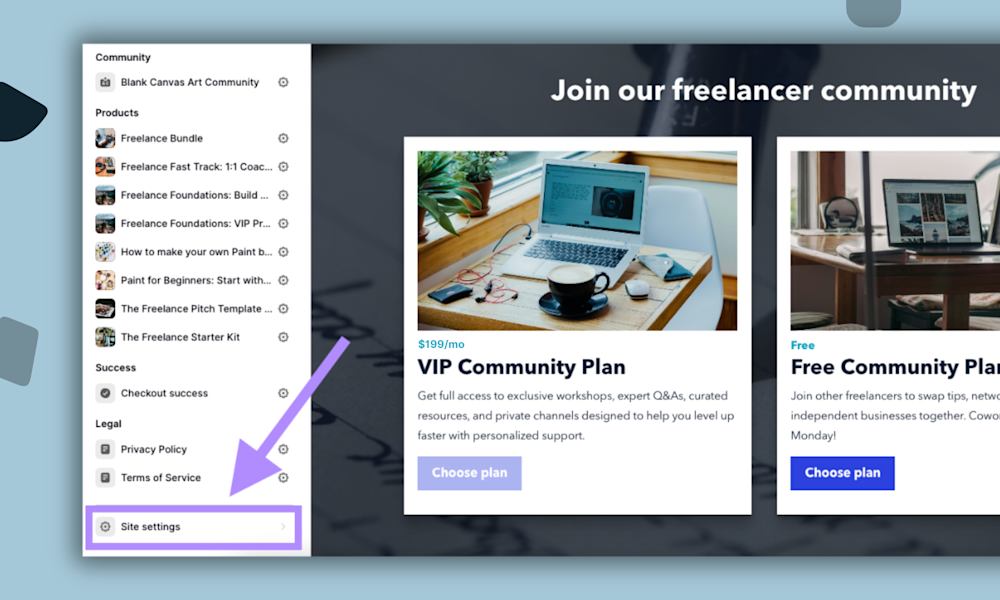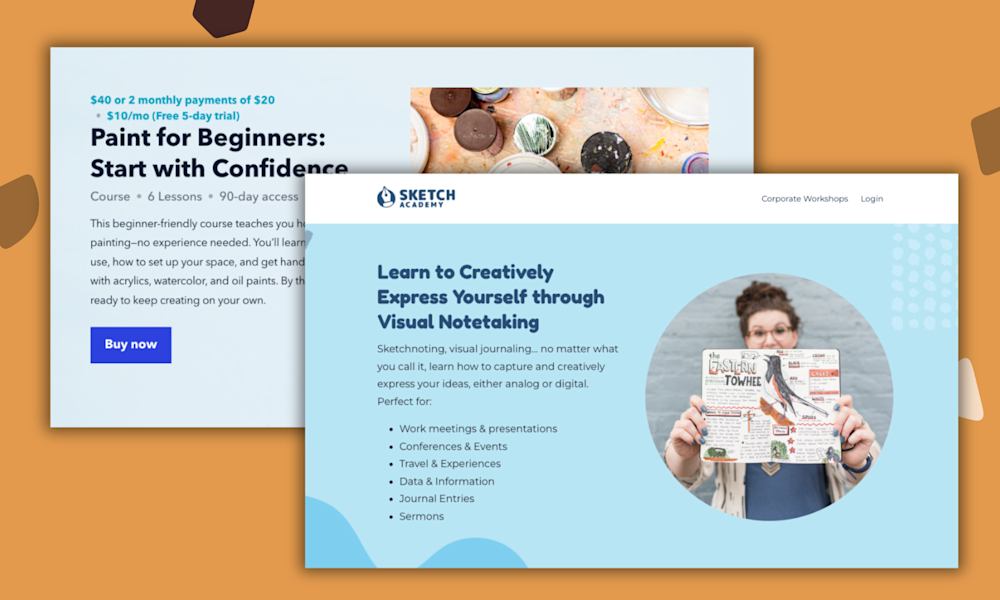If you love music, building a career around it can feel like the ultimate dream. Teaching is one of the most rewarding ways to share that passion, and for many people, in-person lessons are the natural place to start. You get to share what you know, connect with students, and make a real impact.
But over time, the reality of teaching face-to-face can be challenging. You’re often stuck repeating the same lessons with each client, your income is tied to your time, and your student base is limited to people nearby.
Teaching music online can offer a unique opportunity to keep sharing the work you love, minus the less-fun stuff. (No more long commutes!)
If you’ve ever wondered how to take your music business online — and actually make it work — you’re not alone. The good news? It’s totally doable, and it’s easier than you might think.
In this guide, you’ll learn:
-
Why starting an online music teaching business can get tricky, and how to keep it simple
-
The three things you need to start teaching music online
-
Examples and advice from successful online music teachers who have been in your shoes
By the end, you’ll be ready to teach music online and grow a business that gives you more freedom, more income, and more impact.
Teaching music online doesn’t have to be complicated
Once upon a time, the only way to teach music was to meet students in a classroom, studio, or private home. You could only teach so many hours in a week, and your income was forever tied to your availability. Take a week off for vacation, and your earnings dry up.
On top of that, you were limited to your local area, and you or your students might face long commutes to get to lessons.
That’s why teaching music online has become so popular. Now, more than ever, it’s possible to teach from anywhere, reach more students, and even earn money while you sleep.
But here’s the thing, most guides to online music teaching just tell you to get a Zoom account and start, without addressing important questions like:
-
How will students find my music classes?
-
How do I accept payments securely?
-
How do I avoid double bookings?
-
How do I stay in touch with students?
Some music teachers turn to platforms that list them in directories, which can simplify a few things. But those platforms often take a big cut, offer little customization, and don’t give you a reliable way to stay in touch with your students, which could be a problem down the road.
You want to grow something that’s truly yours, not just rent space on someone else’s platform.
That’s why I recommend building your online music business on a platform you own. You’ll have more control and flexibility to grow in the ways that make sense for you.
And it’s easier than you might think.
The 3 things you really need to teach music lessons online: website, digital products, and email marketing
Yep, just those three!
You need a website so people can find you, products so people can book and pay for your programs, and email marketing so you can stay in touch with everyone.
Here’s how to set everything up.
#1 Your website is how people find you
First, you need to set up a website that tells people who you are and what you offer. This is how new and existing customers will find you, book music lessons, and buy your other programs.
Your website can be as simple or involved as you want. I’ve seen beautiful single-page business websites, and equally beautiful full-size websites with product pages, blog posts, and special landing pages for offers and promotions.
(If you’re just starting, go simple and add more pages and design elements as your business grows.)
Your website is a powerful tool for organic discovery because when someone searches for the type of music classes you offer, there’s a chance your site will show up in the search results. And you can improve those odds by adding blog posts that answer common questions your audience has.
That’s exactly how classical piano instructor Joseph D’Amico grew his business, Flex Lessons. He set up a great website and wrote blog posts on topics his ideal students were searching for. He added helpful information to his product pages and used search-friendly keywords in his titles and URLs.
Now, when someone searches for online classical piano lessons, there’s a good chance they’ll find Joseph’s site and sign up. This gives him a steady stream of customers who are actively looking for what he offers.
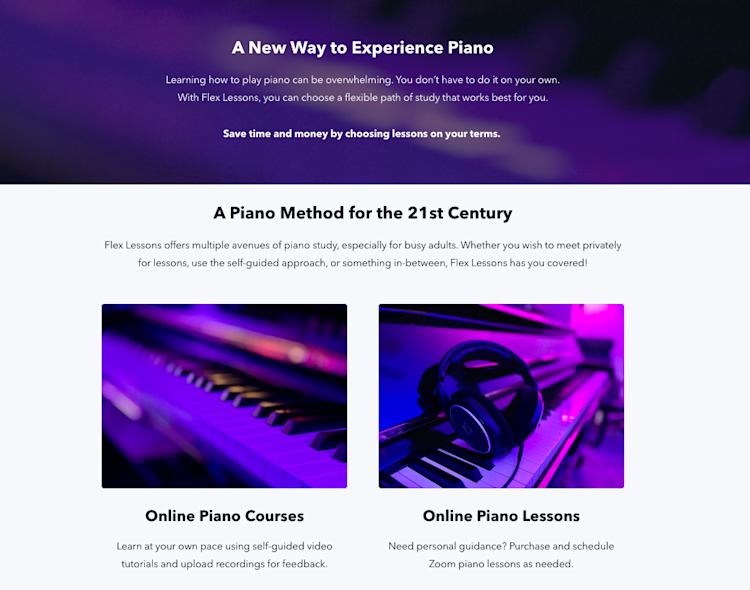
In addition to helping you get discovered naturally by search engines, your website also keeps you connected with your existing audience.
If you mainly post on social media or YouTube, for example, your website is a home base that you control. You can show your products and share your story, all in a space that’s free from distractions and competing content.
But how does someone go from website visitor to paying customer? That’s where your products come in.
#2 Your online lessons, courses, and products are how people learn from you
Once you’ve got your music website, the next step is to decide what kinds of lessons, products, and offers you want to make.
Selling 1:1 online music lessons on Podia
The most straightforward option is 1:1 online music lessons. Your customer can book a virtual session, pay for their class, and you’ll meet using a video platform like Zoom, FaceTime, or Google Hangouts.
You can set this up in Podia by adding a “Coaching” product type, pasting a link to your calendar booking software (like Calendly, SavvyCal, and YouCanBookMe), setting a price, and pressing publish.
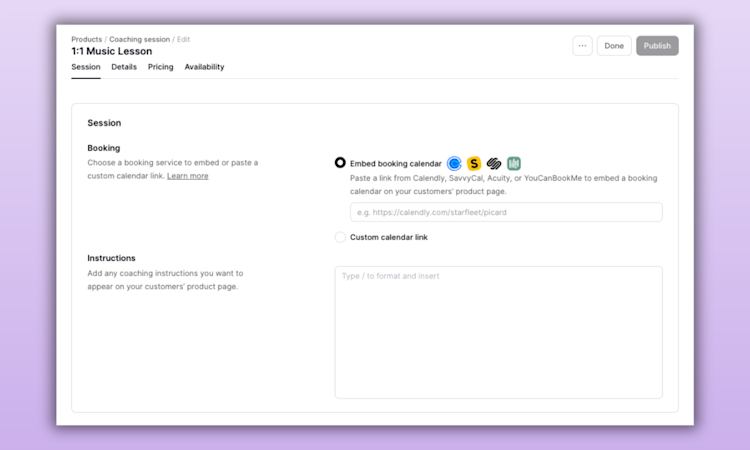
Podia automatically generates a sales page for each product you make, and you can customize this to add more details about your offer. Then, after a prospective customer visits your sales page and signs up for a class, they’ll see your calendar to grab a time slot and instructions for how to prepare.
Offering online courses, digital downloads, and memberships for your music students
Beyond music lessons, you can also expand your music business to include online courses, memberships, and other digital products. Your students can buy these evergreen products any time (hello, making money while on vacation, lounging poolside), and you can sell them as many times as you want without having to do the work again.
Online courses, for instance, are a great fit for students who don’t have compatibility with your schedule or just want to learn on their own time. If you live in Australia and have an interested customer in Canada, an online course allows them to learn from you without having to stay up all night.
Mr. Henry from Mr. Henry’s Music World sells elementary music education content for educators, parents, and students. His music resources are organized into value-packed courses that teachers can sign up for and use in their classrooms. That allows teachers to buy what works with their curriculum and use it when it suits them and their students, all while saving time.
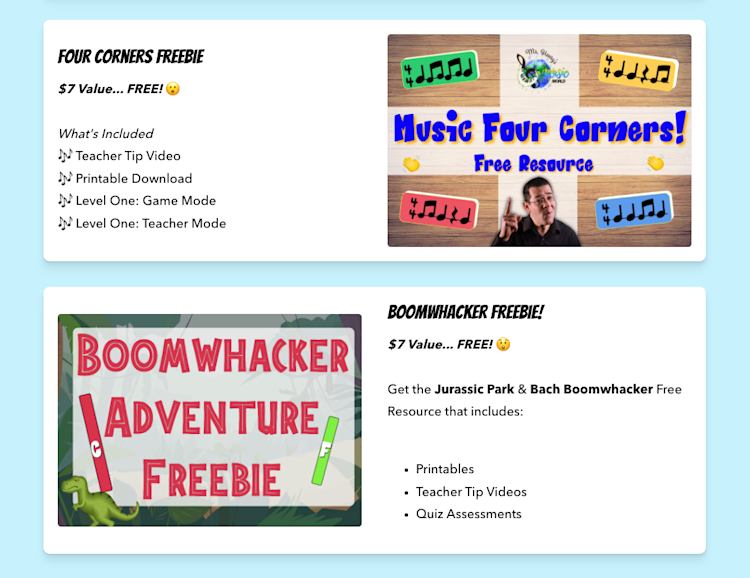
Online courses can also make great free lead magnets. Joseph D’Amico from Flex Lessons offers a free Piano Essentials course that students must take before booking their first lesson together.
He says, “I attract a lot of adult beginners, and I realized that I was saying the same thing to all of my students, almost verbatim. They all have almost the same questions. They are all making almost the exact same mistakes. Surely there’s a way to automate this.”
Now, new students go through the Essentials course first so they have a strong foundation before their live lesson, which saves everyone time.
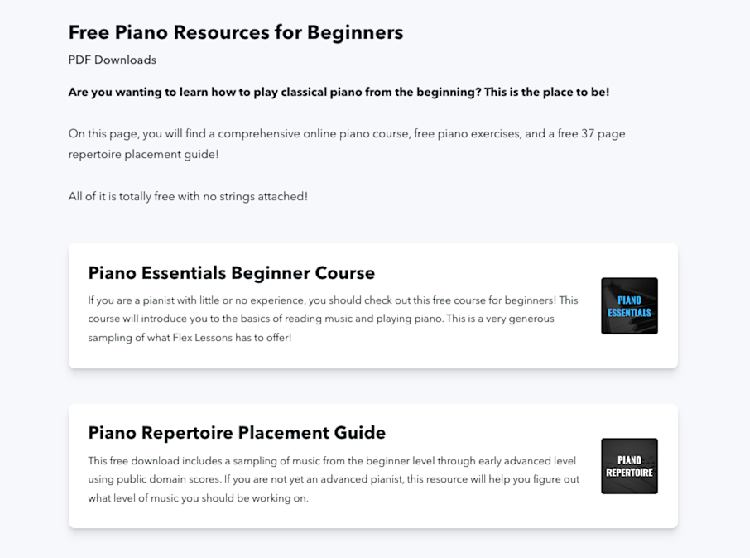
In addition to online courses, we see a lot of successful music creators sell other products like sheet music, practice resources, music journals, and collaborative memberships.
Anne Crosby Gaudet from Music Discovers, for instance, sells harp sheet music along with online lessons and video courses. She also provides free resources like a downloadable weekly practice planner and harp tutorial videos, so prospective students can see her teaching style before committing to a paid program.
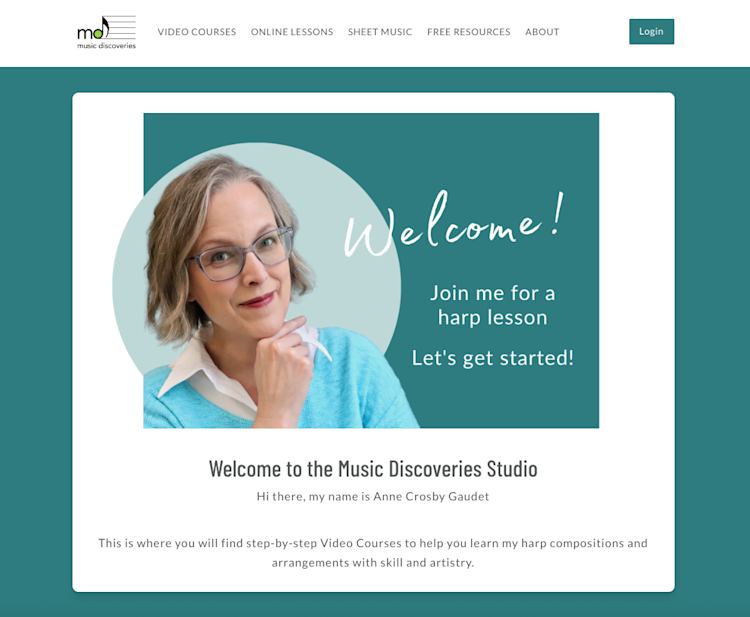
Another option is to set up a membership or community where new content is added on a regular schedule. This allows you to generate recurring subscription revenue, plus it gives your students an opportunity to collaborate. Your membership community can have live programming, exclusive videos, feedback areas — anything that makes sense for your business.
The beauty of doing this with an all-in-one tool like Podia is that you can launch a new product, see what resonates with your audience, and adjust as you go.
#3 Your email marketing is how you stay in touch with everyone
Once you’ve set up your website and products, the last piece of the puzzle is having a reliable way to communicate with students and potential customers. Nothing beats email for this.
Your email list lets you share newsletters, content, and new products with all the people who are part of your business. Anyone who buys a product or lesson from you is automatically added so you can keep in touch, and you can also use this list to build connections with newcomers.
Here’s a quick system that tons of Podia creators successfully use to grow their email list.
First, create a free introductory product and list it on your website. This can be a mini course, a piece of sheet music, a 15-minute get-to-know-you call, a printable practice journal, or any other freebie that makes sense for your business.
Then, when someone signs up for this free offer, automatically enter them into your email welcome campaign.
A campaign is a series of emails that are sent automatically, so you aren’t tied to your inbox 24/7. Your welcome campaign should have three emails that run over the next three days. (You can always add more to this, but if you’re just starting out, three works great!)
-
Day 1: Tell the new subscriber about your business and your brand, and share some info about your musical background.
-
Day 2: Share free resources they might enjoy, like your top blog post or a YouTube video that can get them closer to their music goals.
-
Day 3: Tell them about a paid product they might be interested in, like a private music lesson, online course, or membership to your music community. Ideally, this paid product should connect to your free product at the beginning.
It can be tough to get someone to spend money with your business when you’re still strangers. But by giving lots of value first, your paid offers feel like a natural next step instead of a hard sell.
And the best part is that even if someone doesn’t buy from that Day 3 email, they’re still on your email list. You can still keep them updated with new products and offers, and continue building that connection through newsletters and more helpful content.
Even if students aren’t actively learning with you right now, your email newsletter keeps you top of mind. That way, when they are ready, you’ll be the first person they think of.
And as you make new products, courses, and offers, you won’t have to pitch to an empty room because you’ll already have an email list of people who are ready to hear from you and interested in what you do.
And that’s how you give yourself security long into the future.
You can run your entire online music business all in one place
With a website, a few products, and your email list, you have everything you need to turn your passion for music into an online teaching business.
You’re no longer limited by your schedule, your location, or how many hours are in a day. You can teach students around the world, sell courses and resources that generate income even when you’re not offering lessons, and grow a community of learners who love what you do.
And hey, if you’re looking for a home base to build your music business, we’d love to have you at Podia. Podia brings your website, products, email list, payments, and customer info all into one hub so you can spend more time teaching and less time on tech. Try Podia free for 30 days to see where your music can take you.

